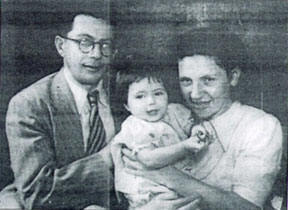The
Jewish Post & News
June 7, 2006
Jewish Winnipegger visits Shanghai,
her childhood home
Written by MARTIN ZEILIG
Judith Lavitt concedes she would not hesitate to return to Shanghai if she had the chance to do so. That storied and sultry South Chinese city, where Lavitt was born 65 years ago, has a hold on her heart.
“I’d do it tomorrow,” she says during an interview in her Garden
City-area home. “It’s in my mind all the time. It’s definitely
worthwhile (to go there).”Lavitt was part of a group of 112 former
Shanghai Jews / Shanghailanders or relatives closely connected to
them, from various countries including 12 from Canada, who visited
there from April 24 to May 5 for the 2006 Rickshaw Reunion — an
International reunion group that meets every two years, but not
always in Shanghai.
This was Lavitt’s first trip to Shanghai since she left there with her parents, Abraham and Liselotte Schaffer (nee Stein), aboard the steamship General Migs in June, 1948, bound for San Francisco via Hawaii.
Just prior to and during the Second World War, most countries in the world shut their doors to Jews fleeing Hitler. There was virtually nowhere for them to go, said another participant on the trip, Yvonne Daniel, during a sermon she gave at Beth El Congregation in Baltimore, Maryland on May 13, 2006.
“Shanghai, however, was an open port city which required no papers or visas, and by the end of June 1939, nearly 10,000 European Jewish refugees had escaped to Shanghai in less than seven months, and thousands more would come totaling close to 20,000.”
Most of those Jews were from Germany and Austria, including Lavitt’s parents. Just prior to the war, her father, who was born in Kosov, Poland, was interned in Saxenhausen, Austria.
“In order to obtain my dad’s release from the camp, my mother had to guarantee that they would leave the country,” says Lavitt, whose mother was from Beccum, Germany. “Mom managed to arrange passage on the ship called the Conte Verde. My parents left Genoa, Italy on March 8, 1940.”
“When my parents first arrived in Shanghai, my dad was in poor health from being in the Saxenhausen camp in starving conditions. When my mother became pregnant with me, both she and the doctor were surprised that my dad had managed to regain so much of his health back to be able to impregnate her. I was born on May 7, 1941 at the Mount Moriah Hospital.”
Lavitt still retains some strong memories of the very hot, humid summers, many flies and mosquitoes, “and all kinds of bugs as well as rats.”
 “As
a small child I felt that life was just fine. I had the usual toys
of the period, went to parks and played with other children in the
Hongkew Ghetto. I remember the lane that led into the courtyard of
our home at 574/9 Dalien Lu (Dalny Road) in Shanghai. During
the rainy season, this road would flood, but the rickshaw drivers
would continue in their bare feet as though the road was dry. My
parents used to talk about how difficult life was during the war,”
she says, adding that she also recalls the air raid sirens sounding
during allied bombing runs over Japanese occupied Shanghai. The
tiny house where the Schaffer family lived, and where Abraham
somehow managed to operate a raincoat factory, with his daughter’s
crib pushed into a corner, doesn’t exist anymore, laments Lavitt,
whose group also had a “big reception” at the Center of Jewish
Studies Shanghai
—
“the most influential research institution on Jewish and Israeli
studies in China”
—situated
within the campus of the Shanghai Academy of Social Sciences in the
heart of the city.
“As
a small child I felt that life was just fine. I had the usual toys
of the period, went to parks and played with other children in the
Hongkew Ghetto. I remember the lane that led into the courtyard of
our home at 574/9 Dalien Lu (Dalny Road) in Shanghai. During
the rainy season, this road would flood, but the rickshaw drivers
would continue in their bare feet as though the road was dry. My
parents used to talk about how difficult life was during the war,”
she says, adding that she also recalls the air raid sirens sounding
during allied bombing runs over Japanese occupied Shanghai. The
tiny house where the Schaffer family lived, and where Abraham
somehow managed to operate a raincoat factory, with his daughter’s
crib pushed into a corner, doesn’t exist anymore, laments Lavitt,
whose group also had a “big reception” at the Center of Jewish
Studies Shanghai
—
“the most influential research institution on Jewish and Israeli
studies in China”
—situated
within the campus of the Shanghai Academy of Social Sciences in the
heart of the city.
Along with the other participants, she took part in a banner — which has a Star of David — signing ceremony in Huo Shan Park (formerly Wayside Park), “where many of us played as children,” in the middle of the Hongkew District.
“The banner is going to UNESCO to ask them to make the whole Hongkew area a World Heritage Site. We also went to the building that housed the Ohel Rachel Synagogue, which is now a museum,” explains Lavitt, who, along with her brother, Bert Schaffer — who was born after the family arrived in San Francisco in 1948 — had some wartime memorabilia on display during the Shanghai Connection Exhibit (and related events) at the Jewish Heritage Centre in the Asper Campus in2001.
“Many tears were shed. I found it all very emotional.”